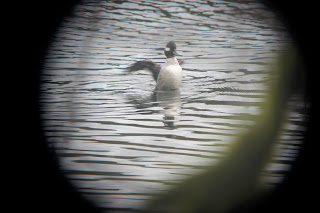Signs of Spring
It may not be spring on the calendar for another month, but around here, nature already thinks it has come. The temperatures are mild, the trees are putting out buds, tulips and daffodils are pushing out of the ground, and the birds are singing and pairing up for mating and nesting season.
In estuaries, bays, creeks, and ponds, the ducks are also caught up in springtime behavior. There are male-female pairs at every 'ducky' location I've visited.
Male & Female Barrow's Goldeneye Ducks

Pair of Golden-Eyes in Bellingham Bay, Boulevard Park

Male and Female Wood Duck pair at Scudder Pond, Bellingham
(This was from late winter, last year.)
Mallard Ducks are mating. At Lake Padden, I observed a pair of Mallards swim off from the main body of ducks. They went over to shallow water near the shore of the lake, where trees and shrubs overhang the shoreline. In this relative privacy, they began to display to each other. Facing each other, they began to dip their beaks in the water, in unison, a form of head bobbing. After a half a dozen of these beak dips, the male mounted the female and they copulated for about three seconds. Immediately afterwards, the male moved off about two meters away and the female half rose out of the water with wing flaps, settled, and then preened.
American Wigeons are also displaying. The photos that follow are included to show various displays. If you learn these displays, you will begin to see more about duck 'sociology'. One of the easiest courtship displays to see is when a female and male head bob in unison. Another, which is so obvious, many don't see its significance, is that the male and female swim together...usually with the female following the male.
Mock Preening and Wing Lift/Wing-Bar Display
This combination of displays is basically meant to say, "Look at me!"
The lifting of the wing allows the color patch that is on many male ducks to be seen. The duck is not really preening. It is part of this, "Here I am!" display. If this is done to the female partner, she may do the wing-life/mock preen stance in unison with the male. It becomes a courtship signal. In this photo you see an American Wigeon male.
Wigeon Wing Lift/Wing-Bar Display
Half-Rise From Water, With Wing Flaps
Common Goldeneye
This can be a courtship display.
Pair Strengthening Displays/Mutual Looks
American Wigeons
I was observing a flock of wigeons on Lake Padden. Suddenly, there was a disturbance that engulfed a dozen of the birds. From a distance, it looked like a brawl or melee. Through the binoculars, the disturbance was all caused by one duck, charging the others. This is what it looks like: a macho display.
Charging/Dominance Display/Head Forward/Rapid Swim/Vocalizing
Another Example of Mock Preening
Watching ducks for identification can be frustrating, especially for beginners, children, and adults with vision problems. Watching ducks for BEHAVIOR, however, is something everyone can do for enjoyment. This may be a good way to get children involved in bird watching.








